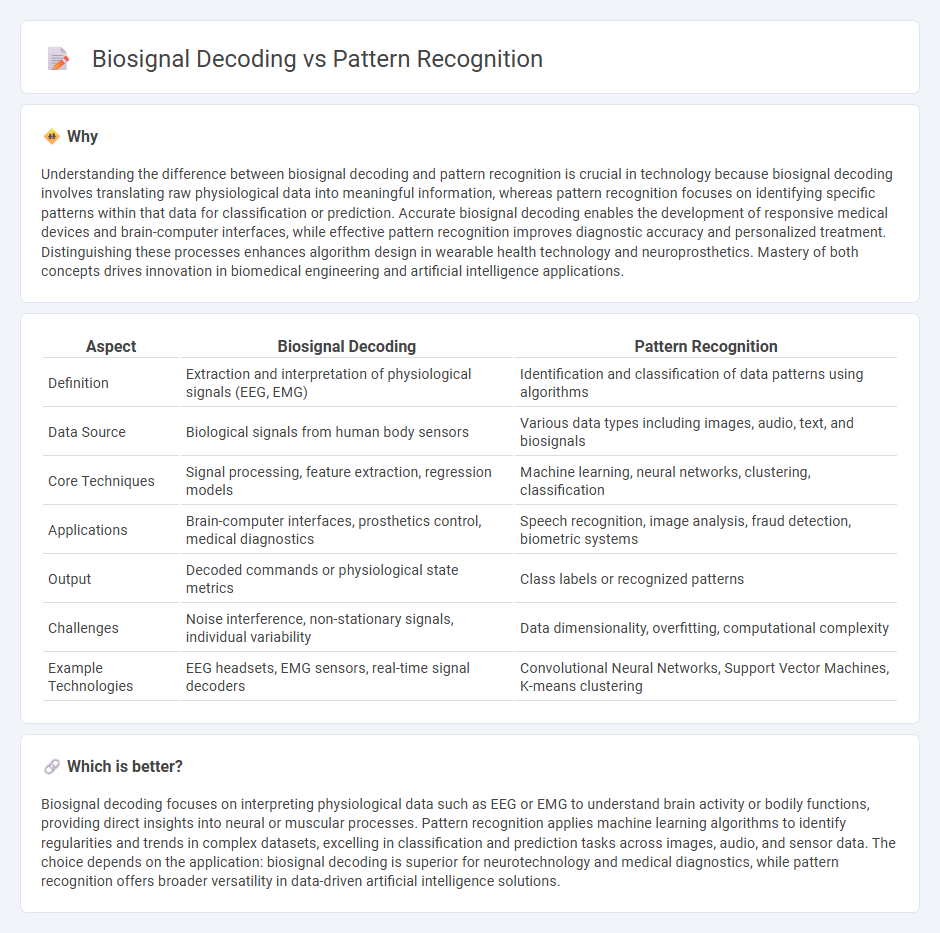
Biosignal decoding involves translating raw physiological data such as EEG or ECG into meaningful information for medical diagnostics and brain-computer interfaces. Pattern recognition uses algorithms and machine learning techniques to identify and classify complex patterns within biosignals, enhancing accuracy and real-time responsiveness. Explore cutting-edge advancements to understand the differences and applications of these transformative technologies.
Why it is important
Understanding the difference between biosignal decoding and pattern recognition is crucial in technology because biosignal decoding involves translating raw physiological data into meaningful information, whereas pattern recognition focuses on identifying specific patterns within that data for classification or prediction. Accurate biosignal decoding enables the development of responsive medical devices and brain-computer interfaces, while effective pattern recognition improves diagnostic accuracy and personalized treatment. Distinguishing these processes enhances algorithm design in wearable health technology and neuroprosthetics. Mastery of both concepts drives innovation in biomedical engineering and artificial intelligence applications.
Comparison Table
| Aspect | Biosignal Decoding | Pattern Recognition |
|---|---|---|
| Definition | Extraction and interpretation of physiological signals (EEG, EMG) | Identification and classification of data patterns using algorithms |
| Data Source | Biological signals from human body sensors | Various data types including images, audio, text, and biosignals |
| Core Techniques | Signal processing, feature extraction, regression models | Machine learning, neural networks, clustering, classification |
| Applications | Brain-computer interfaces, prosthetics control, medical diagnostics | Speech recognition, image analysis, fraud detection, biometric systems |
| Output | Decoded commands or physiological state metrics | Class labels or recognized patterns |
| Challenges | Noise interference, non-stationary signals, individual variability | Data dimensionality, overfitting, computational complexity |
| Example Technologies | EEG headsets, EMG sensors, real-time signal decoders | Convolutional Neural Networks, Support Vector Machines, K-means clustering |
Which is better?
Biosignal decoding focuses on interpreting physiological data such as EEG or EMG to understand brain activity or bodily functions, providing direct insights into neural or muscular processes. Pattern recognition applies machine learning algorithms to identify regularities and trends in complex datasets, excelling in classification and prediction tasks across images, audio, and sensor data. The choice depends on the application: biosignal decoding is superior for neurotechnology and medical diagnostics, while pattern recognition offers broader versatility in data-driven artificial intelligence solutions.
Connection
Biosignal decoding relies on advanced pattern recognition algorithms to interpret complex physiological signals such as EEG, ECG, and EMG with high accuracy. Machine learning techniques enhance the extraction of meaningful features from noisy biosignals, enabling real-time applications in brain-computer interfaces and medical diagnostics. Effective integration of biosignal decoding and pattern recognition accelerates innovation in personalized healthcare and neurotechnology.
Key Terms
Machine Learning Algorithms
Machine learning algorithms are crucial for both pattern recognition and biosignal decoding, enabling the extraction and classification of complex features from EEG, ECG, and EMG data. Techniques such as convolutional neural networks (CNNs) and recurrent neural networks (RNNs) excel in capturing temporal and spatial patterns in biosignals, enhancing accuracy in applications like brain-computer interfaces and health monitoring. Explore advanced machine learning models and applications to deepen your understanding of their impact on biosignal analysis.
Signal Processing
Pattern recognition in signal processing involves extracting and classifying features from raw data to identify meaningful patterns, while biosignal decoding interprets physiological signals like EEG, ECG, or EMG to understand underlying biological processes. Advanced algorithms such as machine learning and deep neural networks optimize both tasks by enhancing accuracy and reducing noise in biosignal interpretation. Explore innovative techniques and applications in signal processing to deepen your understanding of these interrelated fields.
Feature Extraction
Feature extraction is pivotal in both pattern recognition and biosignal decoding, where it transforms raw data into meaningful representations that facilitate accurate classification and interpretation. Techniques such as wavelet transform, principal component analysis (PCA), and common spatial patterns (CSP) are extensively used to capture relevant temporal, spectral, and spatial characteristics from biosignals like EEG, ECG, and EMG. Explore more about how advanced feature extraction methods enhance the precision and efficiency of biosignal decoding and pattern recognition systems.
Source and External Links
What is pattern recognition? A gentle introduction - viso.ai - Pattern recognition is the ability of machines to identify patterns in data and use them for decision making or predictions, with major approaches including statistical, syntactic, and neural pattern recognition techniques.
What is pattern recognition - Arm(r) - Pattern recognition uses machine learning algorithms to automatically recognize patterns in diverse data types like text, images, and sounds, with applications in image processing, speech recognition, and medical diagnosis.
Pattern recognition - Wikipedia - Pattern recognition in machine learning refers to assigning classes or labels to input data based on extracted features, encompassing tasks such as classification, regression, and sequence labeling.
 dowidth.com
dowidth.com